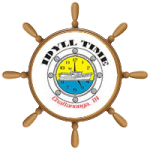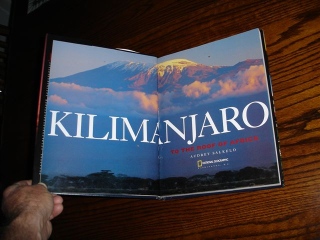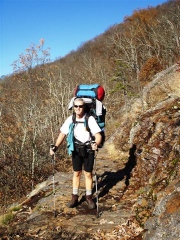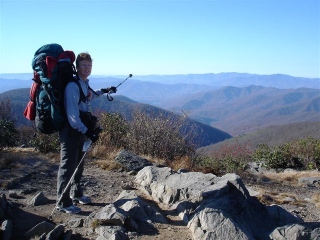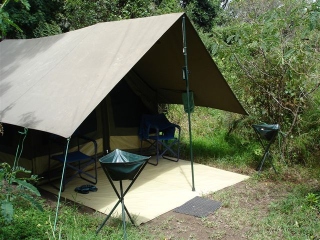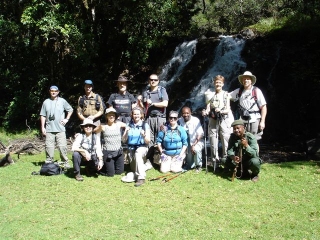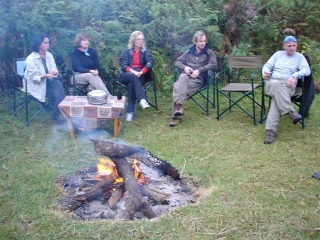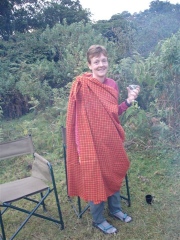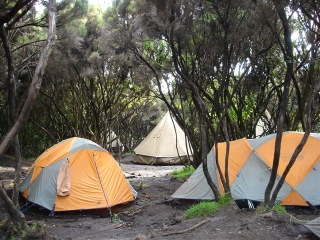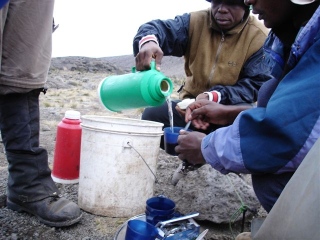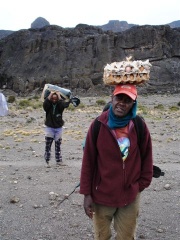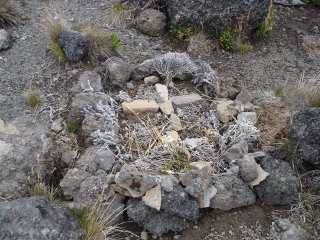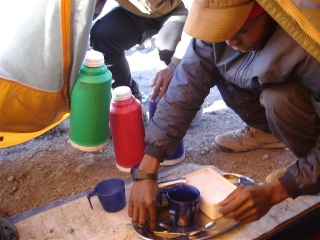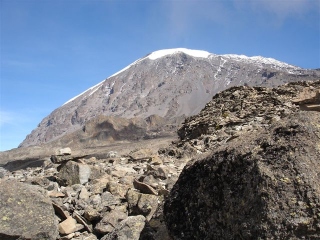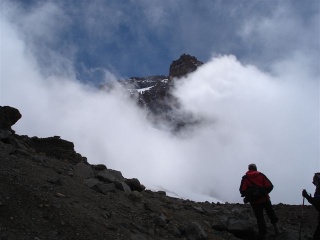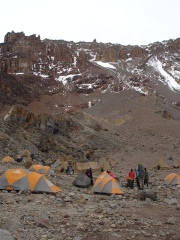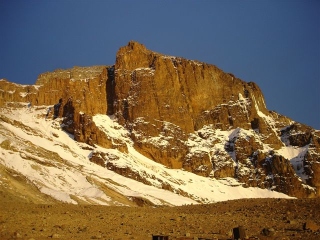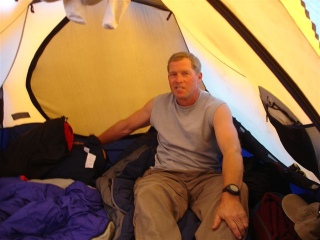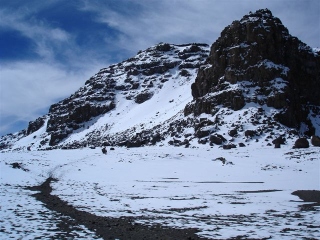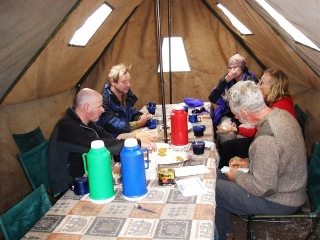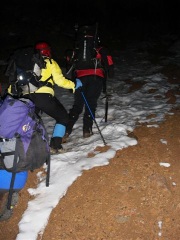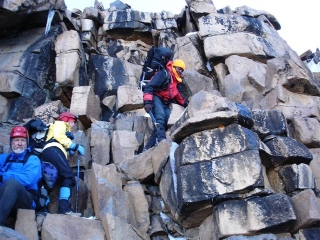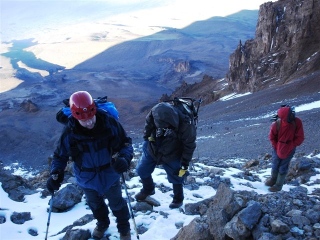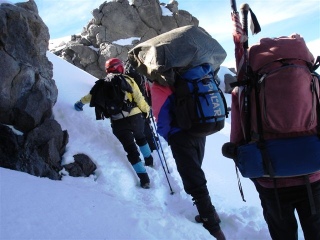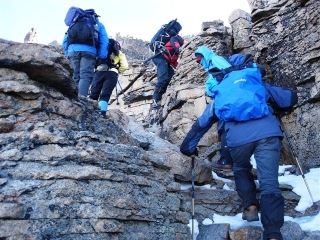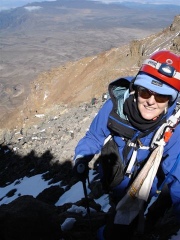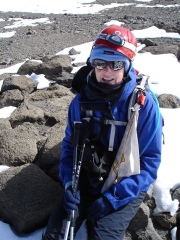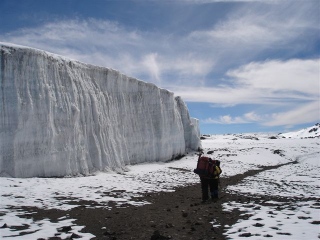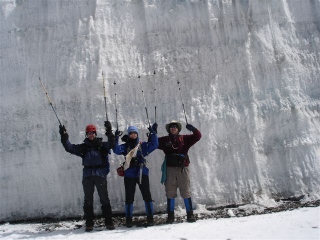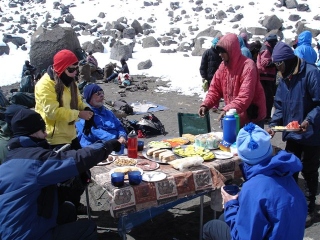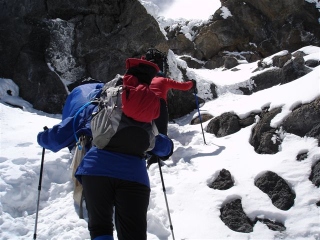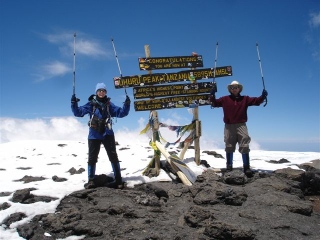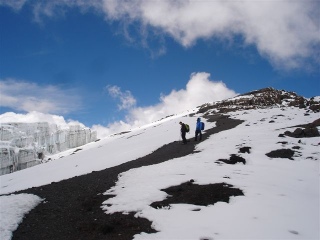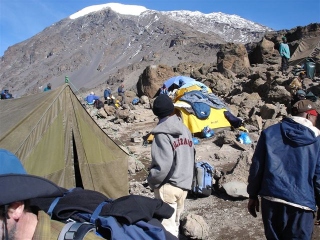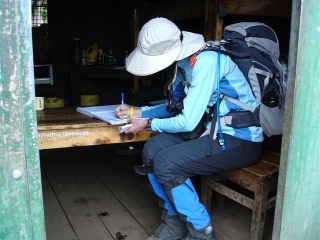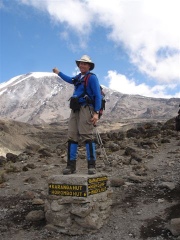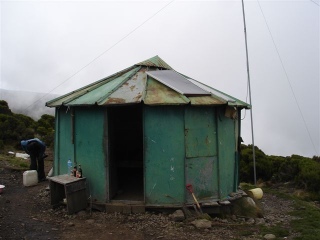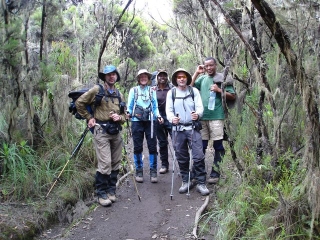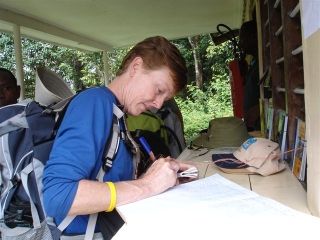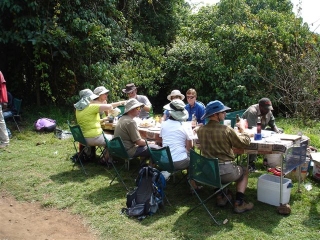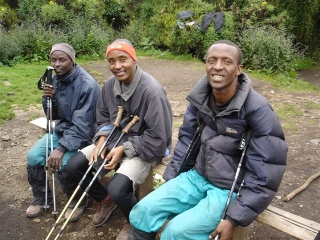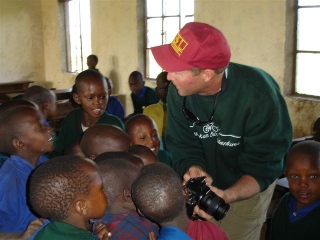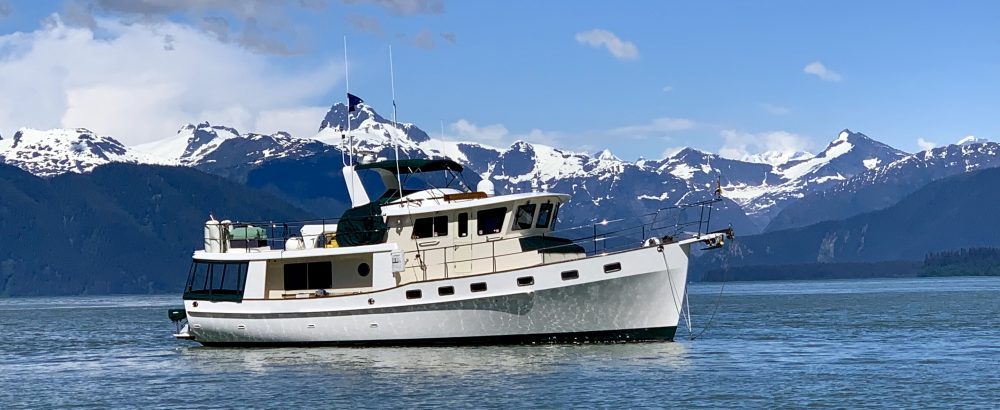
Preparing for Our Climb: December 200
Our departure date for Africa, Jan. 21st, is rapidly approaching. We have spent the last several months at home in Chattanooga preparing for our climb of Mt. Kilimanjaro. Typically, we spend between 4-6 hours daily doing some sort of physical exercise to get our bodies ready for the climb. Many days we load the backpacks with weights (50 and 80 lbs.) and hike the streets of our neighborhood and neighbor’s driveway. All of our neighbors already knew that we were nuts so it does not even raise an eyebrow. In addition to this, we have made several trips into the Smokie Mtns. and also the Nantahala Mtns. of N.C. on backpacking trips typically hiking 10 miles per day carrying heavy packs (40 and 65 lbs) and camping in the cold each night. We think our bodies will be ready for the physical challenge of the mountain.
We have no way to prepare for the altitude on Kilimanjaro and that is our biggest concern. Kilimanjaro is the highest point in Africa. Uhura Peak is at 19,341 feet and is one of the coveted Seven Summits. It is also one of the highest volcanoes and the world’s highest free-standing mountain. Between 20,000 and 30,000 people attempt to climb Kilimanjaro each year. Only 60% are able to reach the summit of this mountain. The main reason for not making it to the summit is due to high altitude sickness. At 19,000 feet there is 50% less oxygen than at sea level. There is no way to predict how one will be affected by altitude. You can be in the best physical condition and still be hit with high altitude sickness. High altitude sickness can be fatal and the only cure is to descend. The most common form of altitude sickness is Acute Mountain Sickness (AMS). Symptoms include headache, breathlessness, nausea, vomiting, dizziness, and loss of appetite. Two more serious forms of altitude sickness are High-Altitude Pulmonary Edema (HAPE) and High-Altitude Cerebral Edema (HACE). HAPE is an accumulation of fluid in the lungs while HACE is swelling of the brain. Both can be fatal and it is essential to get the victim to a lower altitude as soon as possible. The best way to prevent altitude sickness is to go very slowly up the mountain taking as many days as possible along with drinking plenty of fluid. One of the reasons for choosing our travel guides, Wilderness Travel, is that their trip takes eight days to climb whereas other outfitters make the climb in 4-5 days. Hopefully, this will give our bodies time to acclimatize.
We will be climbing what is referred to as the Shira Route. If all goes well, we will reach the summit on Jan. 31st after spending the last night at 18,500 feet where we will camp on the Summit Plateau next to the Furtwangler Glacier. Temperatures on the top can be as low as -10 degrees. After climbing the mountain, we will rapidly descend in only two days. The first descent day will be very grueling as we descend 9,000 feet in one day. The total trek will be about 50 miles over nine days. Can we make it to the summit? Why are we even doing this? These are questions we ask ourselves daily. Stay tuned for the answer.
1-19-08
Only two days before we leave for our big adventure to Africa. We can’t believe it is finally here. We have been planning and training for our climb of Kilimanjaro for over 1 ½ years. We feel ready. All of our gear is laid out in our spare bedrooms. We have checked and rechecked all the gear over the last few days to make sure we have everything. At least twice a day, we just go up into the bedroom and look at everything making sure we haven’t forgotten something. It is amazing how much stuff we have accumulated for this trip. We will be traveling through five different eco zones on our climb. We begin our trek in the Rain Forest Zone with 80 degree temperatures. After leaving the Rain Forest, we traverse through the Heath, Moorland, and Alpine Desert Zones before reaching the Artic Zone. It has been described as walking from the Equator to the North Pole in 8 days. One has to be prepared for just about anything. I think we could open a clothing store with all this stuff. We have also had so many vaccines that we have lost count. In addition to the vaccines, we are carrying along prescription medications for almost any illness. We will start taking our malaria tablets tomorrow and must take them each day we are in Africa and continue for two weeks after returning to the U.S. Our bag looks like a traveling drug store. For the climb, we are allowed one duffel bag each which should weigh no more than 50 lbs. In addition to all of our personal clothing, we also have to fit our sleeping bag, sleeping pad, trekking poles, water bottles, first aid kit, and any snacks into this duffel. I hope it all fits!
Last week we made one final trip to the Smoky’s for some intensive training.
The five days of hard, hard training strengthened our bodies even more for the climb. We hiked between 14-16 miles each day with elevation gains of 4000 feet daily. We tried to get above 5000 feet each day to help our bodies adjust to the altitude they will be experiencing on Kilimanjaro.
Our highest altitude was about 6500 feet on our hike to Clingmans Dome. This is nowhere near the 19,400 feet at the top of Kilimanjaro but it is the highest point here in the southeast U.S. We were very tired at the end of each hiking day but by the next morning ready to go again. Unfortunately, I developed several bad blisters on my feet. I have drastically cut back on my training in the week before our trip in hopes that they will heal. It is very frustrating to have worked so hard for so long and now not be able to continue with the training these last few days. Hopefully my fitness level will not suffer drastically and the blisters will heal before the climb begins. We are both getting a little apprehensive about this adventure. We really don’t know what to expect. Can our bodies adjust to the altitude? How cold will it be on top? What will the food be like? How hard is the climb? Will our knees hold up for the grueling descent? Those are just a few of the questions running through our minds. I do feel we have done everything within our control to prepare for the trip. Now we just have to see if we can make it to the top.
It is an extremely long plane trip to Kilimanjaro. We first have an 8 ½ hour flight from Atlanta to Amsterdam. We then connect on another 8 hour flight to Arusha International Airport which is in Tanzania. Our travel guides will meet us at the airport for a two hour drive to the initial base camp. We have a free day in Arusha to meet with our guide and recheck all of our equipment before the climb begins. We then spend eight days ascending the mountain before making the two day descent. After our climb of Kilimanjaro we will be traveling on a safari to the Serengeti and also the Ngorongoro Crater. This should be a fabulous adventure in itself. Our focus has been on the climb and the anticipation of the safari hasn’t even begun to register in our minds. We return to the U.S. on Feb. 10th at which time we will post all of our logs. If by chance we have internet access in Africa, we will post something about our climb while there. Please join us on this grand adventure.
THE CLIMB:
1/21-22/08 Monday and Tuesday
Today we begin our Kilimanjaro adventure. Our journey begins with a two hour shuttle ride from Chattanooga to the Atlanta airport. Our friends, Mary, Jerry, and Lynne, meet us at Groome Transportation for the two hour drive to Atlanta. In Atlanta, we are joined by Chuck, a friend of Mary and Jerry, who is also a participant on this adventure. We now have 6 of the 11 climbers together. Our friend, Phillip, will join us tomorrow in Amsterdam.
5:20 PM finally arrives and we board our KLM flight for Amsterdam. We were fortunate enough to get a bulkhead seat with lots of leg room. Our flight leaves on time and we are served a nice meal. We are soon flying over Nova Scotia. The land and waterways below are very picturesque with the frozen ice and snow shining in the darkness of the night. After a long 8 ½ hours our flight finally arrives at Schiphol Airport in Amsterdam. It is 7:20 AM here (2 AM Chattanooga time).
Here we meet up with our friend, Phillip, who is traveling from his home in Great Britain. We have become friends with both Phillip and his wife Catherine through our boating travels. Their boat, Jabberwock, is the sister ship to our boat, Idyll Time. Phillip and Catherine were at the Krogen Rendezvous at Solomons, MD back in October. Upon hearing of our plans to climb Kilimanjaro, Phillip was easily convinced to join. His wife, Catherine, had much more sense than the three of us and opted to stay at home.
Our flight to Arusha, Tanzania departs at 9:20 AM. It is another 8 ½ hour flight. This time we have no luck getting bulkhead seats and are jammed in like sardines with no room to move our legs. We are soon flying over the Alps. The snowcap peaks tower above the clouds. It is hard to believe that in a few days we will be climbing a mountain taller than these. At 4:00 PM we look out to see what appears to be desert. At first we are not sure if it is clouds, snow, or desert. It turns out to be the Sahara Desert that we are flying over. What a sight. We are next flying over the Libyan Desert with the Red Sea somewhere to our left but out of sight.
During this flight we see both the sun rise and set. Somewhere in between I think we lost a whole day. At 7:45 PM (11:45 AM Chattanooga time) we cross the Equator. Almost there. Our plane finally lands at Arusha International Airport at 8:30 PM. The airport is small but very clean. Luckily, we already have our Tanzania Visa for entry. Many people do not and there is a long line at the Visa counter. We make it through customs with no problems. Our Wilderness travel guides are waiting for us. Everything is quickly loaded into two Toyota Land Cruiser four wheel drive expedition trucks for the two hour drive to our Mt. Meru camp. We drive for miles on a single track RUTTED dirt road in the dark. This is an adventure in itself. We all look in amazement wondering where the heck we are going. The road is rocky and very dusty. We have several deep stream crossing thrown into this mix. We finally arrive at the camp around 11:00 PM and are assigned to our tents. We have a late dinner before turning in.
Altitude at Camp Meru: 6700 ft.
1/23/08 Wednesday: Mt. Meru Camp
We are up at 7:00 AM this morning. Our climbing team is together for an early breakfast before going for an easy hike around camp. We officially meet our trip leader, Bonaventure. He is a local Tanzania guide and seems very knowledgeable. His assistant leader is Lawrence another local Tanzanian. I think we will be in good hands. We are also introduced to the other three participants on our climb. David and Ilona are a husband and wife team from Carson City, NV and Midge is from Jerome, AZ. The three of them along with Chuck have a huge advantage over the Chattanooga team in that they live at an altitude of around 6700 ft. compared to our altitude in Chattanooga of 660 ft.
We do an easy hike around camp. While hiking a small snake crosses our path and aggressively comes toward David. Our guides get very nervous and yell at David to stay away. They do not recognize this snake but it has a red mouth and they think it may be poisonous. I hope this is not a sign of things to come.
After lunch, we spread all of our hiking gear out for inspection. Boneaventure and Lawrence go through each persons gear to make sure everything is in order. We are impressed by their thoroughness. They seem pleased with our selection of gear. We repack everything in our climbing duffel bag. We are limited to 40 lbs. each so we once again remove several pieces of clothing that we hope we will not need. We want the bags to be as light as possible for the porters.
This evening the group meets around the campfire before dinner.
Boneaventure and Lawrence have bought each of us a traditional Masai covering to wear.
We have a celebratory toast to the Mountain asking for our safe passage. We are then served a wonderful barbeque dinner of chicken, lamb kabobs, and pork chops along with green beans, fresh salad, and homemade pita bread. For desert we have chocolate cake with vanilla cream sauce and lemon cheesecake. It is amazing that they can cook all of this on their small camp stove and oven.
After dinner Bonaventure goes over some more details of our climb. We are all astonished to learn that there will be 70 porters to carry the gear for the 10 of us. We are also given a card for emergency air evacuation if needed on the mountain. Bonaventure strongly recommends that everyone start taking a minimum dose (125 mg) of Diamox which is a sulfur drug commonly used for Acute Mountain Sickness (AMS). I can not take this as I am highly allergic to sulfur. His recommendations really raise my anxiety about getting AMS. Jeff has some Diamox but opts to hold off taking it until he feels any AMS symptoms.
Jeff and I both have a restless night and get very little sleep. The mountain weights heavily on our minds. Tomorrow we begin the climb.
1-24-08 Thursday: Day 1 Climb
We are up this morning at 6:30 AM. We are served a great breakfast of french toast, fresh fruit, and granola. We say goodbye to our two cooks as they will not be traveling with us. There will be new cooks on the mountain. We have a three hour drive to the trail head which again is quite an adventure. The dirt road is extremely rutted out with many stream crossing. We can see Kilimanjaro way off in the distance. It is quite impressive! On our drive, we see several zebra, giraffe, wart hogs, and cape buffalo.
We arrive at the Londorosi sign in gate at 10:30 AM.
We sign a waver acknowledging that climbing the mountain can be potentially dangerous and that we accept full responsibility for anything which may happen. Elevation at the gate is 7600 feet. After signing in, we have another 30 minute drive to the trailhead. Here we meet the porters who will carry all of the gear.
Our climb starts at 11:00 AM at an elevation of 7900 feet. Only 11,440 feet to climb! We quickly enter the Forest Zone and have a very steep climb ahead of us. We follow behind Bonaventure.
He has instructed us that if we want to make it to the top we must follow his advice which is to hike very, very slowly to allow the body to adjust to the altitude. In Swahili they say “Pole, Pole” which is slow, slow. Boneaventure also is constantly stressing to us to “drink, drink, eat, eat, and keep warm”. One of the most important ways to prevent altitude sickness is to make sure that you drink between 3 and 5 liters of water a day. As our altitude increases, our appetite will diminish and we will have to force ourselves to eat.
Today is a short hike with about only three miles to our first camp. Here on the mountain the guides do not use mileage at all. They are always referring to distances in terms of time. It seems no one has figured the mileage between camps. They will always tell you how many hours away something is. We are soon hiking in a tropical rainforest on a very narrow muddy trail. We spot some elephant dung but no elephants. It is very warm today with temperatures in the 80’s. About half way, the porters have set up a nice picnic lunch complete with tables and chairs. We have pizza, fruit, snacks, and carrot cake for lunch.
We arrive at Forest Camp around 3:30 PM. There are two other groups of hikers also at this camp. Our porters greet us and show us to our tent.
Each climber has a porter who will carry his/her personal gear each day. Jeff’s porter is named Stephen and mine is Lashawn. In addition to our 40 lb packs they also have to carry their own personal gear. Most of the porters have very little winter gear and you have to wonder how they handle the cold temperatures on the mountain. It is amazing watching the porters as they balance most of the gear on top of their heads.
The porters soon bring us two bowls of hot water for washing. They will repeat this each morning and evening that we are on the trail. Snacks are available at 4:00 PM each day which consist of popcorn and hot drinks.
Dinner tonight is tomato/ginger soup with french bread. This is followed by chicken/peanut sauce stew with coconut rice and green beans. Desert is apple pie.
The food is very good and everyone has a good appetite.
Altitude at Forest Camp: 9240 feet
Altitude climbed:1620 feet
1-25-08 Friday: Day 2 Climb
Wake up call this morning is at 6:30 AM. The temperature is 65 degrees. I did not get much sleep at all last night. Our porter brings us hot drinks to the tent followed by hot water for washing. We pack up our sleeping bag and clothes into our duffels for the porters. They will disassemble our tent after we leave.
We depart camp at 8:00 AM. We soon leave the Forest Zone and at 10000 feet the landscape has changed dramatically. There are no trees only high shrubs. Today is mostly sunny and warm with temperatures once again in the 80’s. The porters left camp almost two hours after us and have soon caught up to us and speed past so as to set up lunch.
We reach lunch around 11:00 AM. It is so windy that the porters have set up a tent for us to eat lunch in.
After lunch we climb the Shira Ridge to an altitude of 11,500 feet before descending to the Shira Platau Camp. The Shira Plateau is an immense ancient crater and World Heritage Site. It is barren with little vegetation. We get our first view of Kilimanjaro way off in the distance. It seems very far away from here. I am starting to feel the effects of the altitude. I now get out of breath just drinking water. I must take a breath of air between sips. We are all trying to make sure that we drink between 4-5 liters of water a day. The hiking still seems relatively easy at this altitude as we are hiking very slowly. Some of our group has decided to hike faster and have gone ahead of the guides. We feel strong and could hike faster but make a conscious effort to stay behind the guides. They know best how to get us up to the top of this mountain.
We reach the Shira Camp at 3:30 PM.
The camp site is very rocky and desolate with scrub bush all around. The snow caped peaks of Kilimanjaro loom in the distance. There is a park ranger stationed at this camp. We each must sign in on his log book to confirm that we have reached this point.
Dinner tonight is again fantastic for camp food. We have peanut soup, tilapia with french fries, carrots, cucumber salad, and banana fritters with custard for desert. One of our fellow climbers from Chattanooga, Jerry, is not feeling well. He is having headaches and skips dinner tonight. We hope he improves during the night. Hopefully I will get some sleep tonight as I have only had about four hours sleep in the last four nights. I know my body needs to sleep if it is going to be able to adjust to the altitude.
Altitude at Shira Camp: 11,300 ft.
Total ascent today: 2990 feet
Total descent today: 690 feet
Total hiking time: 7 ½ hours
1-26-08 Saturday: Day 3 Climb
I was finally able to get about five hours sleep last night and feel much better this morning. Camp was very noisy during the night. The porters seem to stay up all night talking. Wake up call this morning is 6:30 AM. I still have a slight headache from the altitude. Jerry is not feeling well at all. We heard his wife earlier this morning waking David and asking him to come check on Jerry. David is an emergency room doctor and it is comforting to have him along on the hike. The porters bring hot drinks and water to our tent.
They also check each morning to see how we are feeling and how we slept the night before. They then report to Boneaventure the health status of all the participants. Boneaventure has stressed to us that we notify him immediately if we are not feeling well. By knowing early on of any signs of altitude illness, he can help us to prevent it from getting worse.
Jeff helps Jerry pack up his sleeping bag. He doesn’t have the strength to pack it. In addition to the headaches, Jerry also has a fever which is not a sign of altitude sickness. We are thinking he may also have the flu. David and Boneaventure decide to give Jerry both Diamox and Dexamethasone (both high altitude drugs) to see if he improves. We decide to wait an extra 30 minutes before leaving camp to give these drugs time to get into Jerry’s system.
Jerry is still very weak but wants to continue. We leave camp at 9:00 AM. Jerry, Mary, and Lynne take it slow and we hike on ahead with another guide, August.
We later learn that Jerry did not have the energy to continue. Jerry’s wife, Mary, decides to hike out with Jerry. Our guide Lawrence hiked down with them to the road where they would call an emergency car to pick them up. They are fortunate as this is the last camp that any vehicles can reach. They only have a short hike to the emergency road. We are extremely sad and also concerned when we hear this news. We are sorry we were not there with them when they left the trail. I know they are disappointed in not being able to continue but it is a wise decision. Sickness on the mountain is not to be taken lightly.
About 11:00 AM, my headache worsens. I am sure it is from the increase in altitude. Lynne catches up to us just before lunch. She was with Mary and Jerry when they had to leave. She said Jerry was very weak and wanted to lie down and rest for 30 minutes. That is when the decision was made that he needed to go down. Midge and Chuck are again hiking ahead of everyone today. They live at over 6000 feet so the altitude has not seemed to bother them. I hope they are not hiking too fast. After lunch, we reach Fisher Camp. Here there is a plaque in memory of Scott Fisher who died on Mt. Everest several years ago. This was a favorite spot of his so the camp has been dedicated in his memory.
This afternoon we scramble over many boulders as our altitude increases. There is very little plant live. At 13,000 feet we see some scat from a cape buffalo. You have to wonder why these animals are at this altitude. We reach Moir camp at 3:30 PM. This camp is in a massive bowl with rock walls on three sides.
My head is now pounding. I lay down for several hours before dinner and it seems to improve slightly. Ilona has developed migraine headaches for the second day in a row. She has made the decision to hike out in the morning. This is the last camp from which you can hike out to the road. Anyone with problems once we climb higher will have to stay at a camp lower on the mountain until everyone else finishes. Because of this, she decided it was wise to hike out in the morning.
Dinner tonight is onion soup, rice with beef, zucchini and carrots, and corn and bean salad. There are brownies for desert. After eating several bits, my appetite disappears. I try and force myself to eat as much as possible.
After dinner I feel very nauseous and also have a really bad headache. The headache is the worst that I have ever experienced. Tonight I take both anti-nauseous medicine and also Tylenol for my headache. I am starting to wonder if I will have to hike down with Llona in the morning. I never thought that I would feel this bad at 13,000 feet. We still have over 6000 feet to climb. If I am having this much problem at this altitude, how will I every deal with 19,000 feet?
Altitude at Moir Camp: 13,400
Ascent: 2200 feet
Descent 80 feet
Total Hiking Time: 6 hours 45 min
1-27-08 Sunday: Day 4 Climb
As our altitude increases, the temperatures are starting to decrease. The low temperature last night was 40 degrees. It was another restless night. Neither Jeff nor I were able to get much sleep. Jeff also developed a slight headache last night but is much better this morning. My headache is not nearly as bad as yesterday. I still have indigestion. This is something that has never bothered me so I am sure it has to do with the altitude.
This morning we see one of the other groups taking one of their climbers down. They have him on oxygen and he is being supported on both sides by porters as they make their way down. He looks really bad. We also learned that several porters from that group had to go down yesterday due to altitude illness.
Ilona says goodbye to her husband David before heading down.
Lawrence and several porters hike down with her. She will hike out to the emergency road. From there, Lawrence will call the emergency car. Ilona plans to meet up with Mary and Jerry back at the lodge and hopefully go on a safari while we are climbing the mountain. It is very emotional each time a member of our group has to go down. I have to wonder if I will be next. So far the physical exertion of the hike has been relatively easy. Jeff and I are both in good shape and don’t feel that the hiking is very hard. The physiological effect of the altitude is the hard part. My body is really feeling the effect of altitude and there is nothing I can do about it except to follow Bonaventures instructions of “eat, eat, drink, drink, stay warm”. We now have only seven remaining in our group.
We leave Moir camp at 8:30 AM and are headed for Lava Tower. We have a steep climb through a lava debris field.
At 10:00 AM we cross the Shira trail junction. We soon see a stone cross along the side of the trail.
Boneaventure tells us that this marks the spot where someone died last year. This climber developed altitude illness at 16000 feet and was hiking down. He laid down on the trail in this spot and died. This really scares me. I start to wonder why the heck we are doing this. You really have to respect the altitude.
Our group becomes very somber as we continue hiking up the mountain. We can see the peaks of Kibo in the distance. We still have a very long distance to hike before reaching this summit. We reach our camp at Lava Tower around 1:30 PM. We will stay at this altitude for two nights in hopes that this will help our bodies adjust to the altitude. Lava Tower is a 200 foot pillar of previously molten lava. We are sheltered on two sides by big rock formations. Our camp is at the base of the tower.
The Western Breach looms in the background.
Lunch is served right after arriving at camp. One of our cooks, Marley, went down with Llona this morning. He too was suffering from the altitude. I am only able to eat chicken noodle soup and crackers. As I am walking back to the tent after lunch, I feel as if I am going to faint. I am very dizzy and weak. My headache is raging once again. Jeff meets with David and Boneaventure to discuss my headaches. They decide to continue with the Tylenol. If my headache is not better before climbing the Western Breach two days from now, they will give me dexamethasone which is a strong steroid. After lying down for about 30 minutes I start to feel better. Jeff seems to feel little effects of the altitude.
The clouds come in this afternoon. It becomes very windy and fogy with the temperature dropping to 45 degrees. By dinner I feel much better. We have another great meal of zucchini soup, pasta with eggplant marinara and garlic bread along with a mozzarella/tomato salad with basil.
Altitude at Lava Tower: 15,000 feet
Total ascent today: 1630 feet
Total descent today: 120 feet
Hiking time: 4 hours 15 min.
1-28-08 Monday: Day 5 Climb
The low last night was 31 degrees. My headaches would come and go during the night. Even so I managed to get several hours of sleep. I still have a very slight headache this morning. My resting heart rate is now about 10 beats higher than normal. Jeff still doesn’t seem to be bothered by the altitude. Chuck, Jeff, and I are the only three not taking the Diamox. I really wish that I could take it but am highly allergic to sulfur. I think that if I were able to take Diamox, I would not be having the headaches.
Wake up call is 7:00 AM. The porters bring our room service of hot drinks and water to our tent at 7:30AM.
This morning we have a breakfast of porridge, bacon, eggs, toast, and fruit salad.
We leave at 9:00 AM for an acclimatization hike to Arrow Glacier Camp. This will be our camp tomorrow night but we are hiking up there today so that our bodies can adjust to the increase in altitude. Even though we will still be camping at a lower altitude, this hike helps our bodies acclimate to the higher altitudes.
As we look up at Arrow Glacier Camp, we all wonder how it is possible to reach this camp. The mountain appears to go straight up. How can their possibly be a trail on this steep of a slope? Bonaventure quickly instructs us on how to use what is called “The Mountain Step”. This consists of taking a step with the right foot followed by a deep gasping breath then a step with the left foot followed again by a deep gasping breath. Between steps you lock the downhill knee to shift all weight to that leg thereby reducing muscle strain. You feel as if you are going in slow motion. Bonaventure says that if we want to make it to the top we must use this step for the remaining days on the mountain. By using this step my heart rate never goes above 120 bpm.
Today’s hike is very steep with lots of loose scree. We hike across a big rock field. The top of Kilimanjaro is hidden in the clouds. Walking so slowly, you feel as if you will never get very far. However, one look back at our camp below and I quickly realize we have climbed quite a bit. Our tents look like small ants down below us. We stop every 30 minutes to rest and drink. I really have to force myself to drink the required 3-5 liters of water needed each day. The altitude and increased fluid intake results in tremendous quantities of urine output. During the day and night we are constantly peeing. It is really aggravating having to get out of the sleeping bag to pee every two hours during the night. We have pee bottles inside our tent so that we do not have to get out of the tent during the night.
On our way to Arrow Glacier, we see snow for the first time along the trail. We reach Arrow Glacier Camp at 12:30 PM. Bonaventure is very happy that we have all made it to this point today. He tells us that we are the first group he has ever guided to make it all the way to Arrow Glacier on this hike. All of his previous trips have turned back before reaching this altitude. Here we have reached an altitude of 15,530 feet. Our bodies have never been to this height before. We all feel very pleased to have made it here today.
We get a good view of the Western Breach from this camp. The jagged cliffs look very cold and inhospitable.
They appear to rise straight up. Bonaventure assures us that there is a trail up there. The clouds start to roll in so we quickly retrace our steps and head back down the steep loose scree to our camp at Lava Tower.
We arrive back at camp at 1:30 PM, just in time for lunch.
I force myself to eat vegetable soup, fruit, cheese, and bread. The altitude is even starting to have an effect on Jeff’s appetite. He is now eating what a normal person would eat not his usual two to three plates. I am still fighting indigestion. The Aleve and Tylenol seem to have eased my headache slightly.
This afternoon Jeff, Chuck, David, and Phillip decide to climb Lava Tower with Lawrence.
I decide to conserve energy for tomorrows hike and stay at camp. They climb the 200 feet to the top of Lava Tower. Upon returning, Jeff said it was good that I did not go. He said it was very vertiginous with hand over hand climbing to reach the top. I would not have been a happy camper on that climb. This afternoon Jeff decides to shave for the first time since being on the mountain.
Dinner tonight is vegetable soup, pancakes, and rice with mushrooms. I manage only a few bites. Even though my body has had very little food the last few days, I just don’t feel hungry at this altitude. Jeff’s appetite has diminished also.
During dinner Bonaventure instructs us that upon reaching Arrow Glacier Camp tomorrow we are to stay around the tents and not venture too far away from camp. He is afraid of possible rock slides in the afternoon as the temperatures rise and the snow and ice start to thaw. Bonaventure also tells us several horror stories he has experienced of climbers who have become very sick due to the altitude and then had to be evacuated.
I am really having doubts about making it to the top of the mountain. The hiking still seams relatively easy. At the end of the day I still have plenty of energy. However my body is still struggling with the altitude. I know that if my headaches continue, I should not risk climbing any higher than Arrow Glacier. Even if I make it no farther than this camp, the experience has been incredible. I can’t even begin to describe what the climb has been like. We have hiked through many different zones, all so amazing and different. The mountain seems to have a magical spell. Our interaction with both the porters and guides has also been very enriching. They have been a pleasure to be around. The porters all carry 50 lb. packs each day, mostly on their heads, hiking almost twice as fast as our climbing group. They are always cheerful and friendly, never complaining. Many do not have hiking boots or winter clothing and do this strenuous work for about $10.00 wages per day. Our porters greet us each day as we approach camp. They are very happy to see us reach the next camp and always congratulate us on the days hike. Climbing the mountain is also very emotional. I never really expected this. It has been really sad each time a group member has had to go down. In the back of my mind, I wonder if I will be next. Seeing people sick on the mountain and also passing spots where people have died really makes you stop and think. The wide mix of experiences and emotions one goes through while climbing this mountain seem so strange.
Total Ascent today: 850 feet
Total Descent today: 850 feet
Highest altitude reached: 15,530 ft.
Altitude at camp: 14,680
Hiking Time: 4 hours 20 min.
1-29-08 Tuesday: Day 6 Climb
We awake this morning to a brisk 25 degree temperature. During the night we were awakened about 1:00 AM by a very loud rumble. It was a rock slide above us on the Western Breach. It sounded very close and I was thinking we were about to be crushed in our tent by the avalanche. I was ready to evacuate the tent but Jeff assured me that we were far enough away.
My headache returned during the night. Jeff and I find Bonaventure before breakfast to discuss this with him. Headaches are one symptom of HACE (high altitude cerebral edema). We decide that I should start taking Dexamethasone. This is a very strong steroid used to treat HACE. Standard mountaineering practice says that you should not hike to a higher altitude with a headache. However Bonaventure thinks I can still hike to the next camp since it is only 850 ft. of climb. I was at this altitude yesterday and did fine. If I have problems it will be easy to hike back down to a lower altitude from the Arrow Glacier Camp.
Our group leaves at 9:00 AM for the next camp. Jeff and I are to wait here at Lava Camp for another hour.
This will give the medicine time to get in my system and hopefully reduce the headache. We watch as the porters pack up the tents. Once they are through, we hike with Lawrence up to Arrow Glacier. The dexamethasone already seems to be reducing my headaches. We practice the “Mountain Step” on our way to Arrow Glacier. We can see the rest of our group ahead as they climb the steep slopes stopping every so often for water breaks. We arrive to Arrow Glacier Camp around noon. Stephen and Lashawn, our porters, hike down the trail to meet us.
They offer to carry our packs the rest of the way to camp but we decline their offer. They have made a name board for our tent out of scrap wood.
This afternoon Lynne is feeling really sick. She has a bad cough, swelling in the abdomen, shakes, and is very weak. Everyone agrees that she should not continue tomorrow and she will hike down in the morning. David then checks her vital signs and feels that she should go down now. He thinks she has HAPE (high altitude pulmonary edema). The only cure is to go to a lower altitude. Her problems could worsen if she stays overnight at this altitude. Bonaventure quickly assembles a porter crew to hike down with her. Lawrence will go with her also. The ability of Bonaventure to work out the logistics each time someone has to go down is amazing. He has to make sure the necessary people and supplies go down. With each person going down he must send porters, a cook, tents, food, a water filter, a port-a-pottie, emergency oxygen and medical supplies, ect. He must also make sure that there are adequate supplies left on the mountain for the other climbers. He makes these decisions in a split second and the necessary people are soon packing their supplies.
We say goodbye to Lynne at 4:00 PM. She will hike to Meweka Camp and wait there for our group to arrive in several days after our summit bid. We are really concerned about Lynne. She is very weak and pale. We hope she makes it down safely.
This evening we have a briefing on tomorrows hike up the Western Breach. This will be the toughest day of our climb. The Western Breach is a 3000 foot climb up to the crater rim.
Bonaventure has decided that we should leave camp at 4:00 AM instead of the scheduled time of 8:00AM. Our wake up call will be 3:00 AM. There was an avalanche two years ago on this section. Three people were killed. The route has been closed since then and was just reopened several weeks ago. We will be only the second group to travel this route since reopening. He says that the avalanche occurred at 9:15 AM and he wants to make sure we are past that area at that time. He feels that it will be much safer while everything is still frozen. We are each given helmets to wear. The porters will stay in camp for several hours after we leave. He does not want them to pass us while we are climbing the Western Breach as he is concerned of rocks falling from above. I start thinking about the rock slide we heard several nights ago and am wondering how safe this route is going to be.
The dexamethasone seems to be helping but I still have a very slight headache. We decide to wait until 3:00 AM to decide if it would be safe for me to ascend any higher. Once we start climbing up the Western Breach, there is no turning back. If my headaches worsened, I would have to continue up to 18,500 feet before joining the trail on the other side of the mountain for descent. This makes the decision even tougher. As much as I want to reach the top, I know that I should not continue to that extreme altitude with a headache. If my headache is gone at 3:00 AM, I will continue. Otherwise I will hike down and join Lynne.
We have an early dinner before turning in. I don’t think anyone is hungry tonight. In addition to being nervous about tomorrow’s climb, the altitude seems to be affecting everyone’s appetite. We can’t believe what the cook brings out for dinner tonight. Everyone is expecting a good meal of pasta or rice before the climb. The cook brings out a huge plate of HOT DOGS! Not a single one is eaten. This is the last thing we wanted to see at 15,000 feet the night before our big climb. We do however also get rice, grilled squash, caramel custard, and banana bread. I force myself to eat these other dishes
knowing that I will need the energy for tomorrow’s climb.
We turn in after dinner for our early morning wake up call. Jeff and I organize our backpacks for tomorrows hike.
Tonight we decide to sleep in tomorrows hiking clothes. It will be cold tonight and we will need this extra warmth. At 3:00 AM we will be ready to go. Still concerned about the Western Breach, I ask Jeff if he thinks the climb will be dangerous. He assures me that it can’t be too difficult because the porters have to carry those heavy packs up it. Even though we don’t see a trail, he says there has to be one for the porters. This makes sense and I feel much better about tomorrows climb (little do I know what awaits us).
I pray that my headache is gone at 3:00 AM. We have trained so hard and long for this. I really hope I can reach the top.
Total Ascent Today: 850 feet
Total Descent: 0
Altitude at Camp: 15,530 feet
Total Hiking Time: 1 hour 45 minutes1-29-08
1-30-08 Wednesday: Day 7 Climb
Wake up call is 3:00 AM. I am already awake as I don’t think I slept even an hour last night. My headache is gone. I am going to climb!
The low last night was only 25 degrees (much warmer than we expected). We both stayed warm with all the clothes we have on. It is a crystal clear morning. The sky is incredible at this altitude. There are billions of stars in the heavens. What a perfect morning to climb the Western Breach.
We have a light breakfast of porridge, toast, and fruit before leaving camp. At 4:00 AM, Bonaventure leads our group of six out of camp.
We have four other porters with us. One is carrying oxygen and a gamow bag in case of problems. Our headlights are affixed to our helmets. We rapidly start to ascend the steep rocky scree. There are many small boulders and loose rocks along the trail. We soon come to a switchback. Bonaventure instructs our group to stay very close together so that no rocks will fall on the hikers below. We can see only a few feet in front of us. I think it is probably good that I can’t see below us. The climb becomes increasingly steeper. At 16,000 feet we are breathing rapidly even using the snail pace of the “Mountain Step”. We are hiking at about only one mile per hour and yet still gasping for breath in this thin air. My heart rate is about 20 bpm higher today than any of the previous days.
As we go higher, the trail becomes increasingly treacherous. We travel through a section of loose scree on a 40 degree slope. There is no trail on this section. One wrong step and you will be sliding 2000 feet down the mountain. We next cross a large boulder field. I feel certain this is where the avalanche occurred two years ago. I am thankful that it is still dark. I don’t want to see what is above or below. We next come to a section of vertical rock wall. We begin a hand over hand climb.
There are places in which I can barely reach the next rock. One slip here and again you will fall over 1000 feet. Just when I think we have passed the most difficult sections, it gets worse. We have several snow and ice fields to cross. Bonaventure has to cut steps into the snow with his ice ax. There is no trail. At 6:15 AM it is light enough to turn off our headlamps. For the first time, we can see below us and where we have come from.
It is a clear cloudless morning with visibility for over 100 miles. The terrain above and below is amazingly steep. What appeared to be the crater rim is actually only the first of several false rims that we have to climb before reaching the crater.
The trail continues to become more vertiginous and treacherous under foot. There is place after place where one wrong step will send you sliding off the mountain.
Each foot and hand placement requires total concentration. Bonaventure stops about half way up the mountain to read a prayer which was sent with him by his wife. He asks the Mountain Gods to safely guide us up the mountain. I soon see why he chose that point to read the prayer. Believe it or not, the trail gets even more treacherous. Midge is following right behind Bonaventure. She is starting to get freaked out and Bonaventure takes her hand guiding her through the ice and rock fields. I also am not believing that we are doing this. It is so scary that I just have to put it out of my mind and concentrate on each step.
There is no turning back at this point. If we were in the U.S., there would be fixed ropes on this climb. Jeff is in front of me and I try to retrace his hand and foot placement. There is a porter right behind me. At times I can feel him grab my backpack in case I start to fall. It is reassuring to know that he is watching out for me. At 9:30 AM, we can see the crater rim above. We only have about 400 feet to go. This section is covered with several feet of fresh snow. No one has been across here since the snowfall. Bonaventure once again cuts steps into the snow with his ice ax. We have a 6” wide trail on a steep 60 degree sloping bank.
I can’t believe we are not roped in. At 10:00 AM, after climbing for six hours, we put our feet on top of the crater rim. We are now on safe ground at 18,300 feet. I just sit down and cry, releasing all of the tension and emotion from this day.
We have reached the “Snows of Kilimanjaro”, a place only a few people will ever see. Everyone is relieved and elated to be here. None of us expected the climb to be so technical. We have an easy half hour hike across the crater to our campsite.
It is beautiful here at the crater with the Furtwangler Glacier next to the campsite. The ash pit can be seen off in the distance.
The 1100 foot trail which leads to the summit begins at the Crater Camp. This trail is completely snow covered and appears to go straight up.
Our porters are here, but they have not yet set up our camp. Our original plan was to camp here tonight and hike to the summit early tomorrow morning before hiking down. By leaving at 4:00 AM this morning, we have arrived here much earlier than scheduled. Bonaventure gives us the option of hiking to the summit today. We all agree that it would make much more sense to continue hiking to the summit now instead of waiting. By waiting until tomorrow, we risk getting altitude sickness during the night and not being able to make the summit. It is also a beautiful cloudless day on top. This may not be the case tomorrow. We all feel strong and want to continue. We also have the option of continuing down to a lower camp after summiting or camping here at 18,500 feet. Midge is the only one who wants to camp here. Jeff, David, Chuck, Phillip, and I want to hike down to a lower altitude. Even though it is beautiful here, we feel it makes no sense to camp at this high altitude. It will be very cold tonight and staying at 18,500 feet increases our risk of altitude sickness. Bonaventure quickly assigns several porters to stay at the crater rim with Midge. He also will stay here with her while the rest of our group hikes down to a lower camp. I am much relived that we are continuing our climb to the summit today and then hiking down. Being on the dexamethasone, I was worried about staying at this altitude overnight and then not being able to make it to the summit tomorrow. After getting so close, it would be disappointing not to make it to the top.
We have a quick lunch and hot drinks before making our final summit bid.
The porters will not climb to the summit with us. They will take an alternate trail around the mountain. There is no reason for them to carry the heavy packs up this steep section.
We depart Crater Camp at 11:30 AM. Though not technical, this section is very steep and we must use the “Mountain Step” if we want to reach the top.
The air is very thin and cold. We are gasping for every breath. At these altitudes there is only half of the oxygen in the air as compared to sea level. At 12:30 PM we are reaching the top of the climb. The view of the crater and ash pit below is one I will always remember. We still have about ½ mile of gradual uphill to hike before reaching the true summit of Kilimanjaro. We can see the wooden sign marking the top way off in the distance.
At 1:15 PM on January 30th, 2008 we reach the top of Africa, Uhura Peak.
The view from 19,340 feet is incredible with Africa stretching out in all directions. No other groups are here and we have the peak all to ourselves. It is a cloudless day here at the top and we feel privileged to have the peak to ourselves. We spend about 30 minutes enjoying this special moment and snapping pictures for our memories.
At 2:00 PM, we say goodbye to Bonaventure and Midge and start our way down the mountain using the Mweka Route. August and Paulo are now our guides. The trail down is a dirt cinder trail. Dust is flying everywhere. With each step you slide another three or four feet. This trail is for descending only. The cinder is about 6” deep and would be impossible to hike uphill. There is a graded parallel trail for those hiking up the mountain. This is the “Coca Cola” trail which most people use to reach the summit.
It would be a long tedious hike using this trail but it offers none of the life threatening challenges that we experienced on the Western Breach route. We all feel like our climb was a real accomplishment. Even though I would probably never climb the Western Breach again, I am glad that we chose that route to the summit. Our route was much more scenic, challenging, and less crowded than these other routes.
We reach Barufu Camp at 4:45 PM.
It has been a long day and we are all very tired. There is a ranger station here and we once again have to sign in on the log book.
This camp is much different than all the others which we have camped at. It is very crowded, noisy, and dirty. Most of the routes to ascend the mountain come through this camp. Many of these hikers are leaving here at midnight tonight to begin their trek to the summit.
Our cooks have tea and cookies waiting on us when we arrive. We have a dinner of noodle soup, rice with peas and onions in a tomato sauce, grilled carrots, and potatoes. We have all regained our appetite. The air at 15,000 feet now seems thick compared to the crater and peak. We are all very tired and retire to bed soon after dinner.
Altitude Climbed: 3850 feet
Altitude Descended: 3800 feet
Altitude at Barufu Camp: 15,400 feet
Hiking Time: 11 hours
1-31-08 Thursday: Day 8
Our camp was very noisy during the night. Many people left at midnight for their summit bid. Our tent is right next to the trail and we heard each one as they left camp. There were also several people in camp who became extremely ill during the night. About 11:00 PM, there was a lady in the tent next to ours calling for help. Jeff was about to get up when he heard her porter arrive. Her husband had HACE and they immediately had him dressed and were taking him down the mountain. Later in the night, Jeff heard another man outside our tent calling for his wife. He had severe diarrhea, was hypothermic, and later became unresponsive. His porters took him to the cook tent to re-hydrate him with warm liquids. They had climbed to the summit yesterday and he too was suffering from the altitude.
The low temperature last night was only 40 degrees. We have a late breakfast at 8:30 AM. During breakfast, Midge and Bonaventure arrive from the higher camp. They left camp this morning at 6:00 AM. They said it was extremely cold at the Crater Camp last night. I think we made the right decision to hike down to a lower camp. We leave camp at 9:00 AM and are again descending a steep rocky trail. We have several good views of the mountain in the background.
We soon pass through the Mooreland and Heath Zones. At 11:30 AM we arrive at the Mweka Camp. Today is a very easy hiking day. It is amazing how much better we feel at this lower altitude. Lynne has already arrived at this camp and it is good to see her. She said she started feeling much better as soon as she arrived at the lower altitudes.
Dinner tonight is Tilapia, avocado and tomato salad, zucchini and carrot medley, potatoes, and chocolate cake with cream sauce.
Total Descent: 4800 feet
Total Ascent; o feet
Altitude at Mweka Camp: 10,600 feet
Hiking Time: 2 ½ hours
2-01-08 Friday: Day 9
Our wake up call this morning is 5:30 AM. Breakfast is at 6:15 AM. After breakfast our group brings any clothing or hiking gear that we would like to donate to the dining tent. Bonaventure spreads it all out on a tarp. We have quite a collection. He then calls the lowest porter up to select one item. This is the first climb up the mountain for this porter and he selects a nice pair of winter gloves. Bonaventure then calls the porters up one by one until everyone has received something. They all seem very appreciative as most do not have appropriate hiking gear. Just before leaving camp, the porters sing a good-bye song to our group in Swahili. We are all sad to be saying good-bye to these wonderful people.
The trail out to the gate is well groomed. Almost everyone uses this main trail on descent. There are several other groups hiking out today also.
We soon enter the Forest Zone. We see several Colubus monkeys in the trees. After several hours of hiking, we reach the park entrance gate at 10:15 AM. Our porters are there to greet us. Many other groups are here also. There are several people selling t-shirts and coca colas. We have to sign off the mountain at the ranger station. Once we are officially signed out, we receive our official certificates for reaching Uhuru Peak, signed by the park warden.
Wilderness Travel has a nice picnic lunch set up for us. Marry and Llona are here to meet us. It is good to see them again.
We say goodbye to our porters, Lashawn and Stephen. We give them our gloves, some socks, thermal underwear, a hat, and our extra power bars as a thank you gift. They have done a very good job of getting us up the mountain.
Total Ascent today: 0 feet
Total Descent today: 4470 feet
Total Hiking Time: 3 hours 15 minutes
Statistics for Climb:
Total Feet Climbed: 13,990 feet
Total Feet Descended: 14,810 feet
9 Days
The climb to the “Top of Africa” is without a doubt one of the greatest adventures that we have experienced. We would highly recommend the Western Breach Route as the ultimate way to reach “the snows of Kilimanjaro”. Would I do it again? Probably not. Am I glad we did it? Yes! It is the trip of a lifetime. Everyone should experience this once in their life.
After completing our Kilimanjaro climb, we still have another ten days of vacation in Tanzania. Before heading off for our safari, we spend one night in Arusha where we enjoy the comforts of Movaro Lodge (especially the hot water shower and nice comfortable beds). We then headed out to the Ngorongoro Crater where we tent camped for two nights in the middle of the Maasai tribe. Here we were treated to a goat roast by the chief of this tribe and were also invited to visit his boma (home). Each day we would travel down into the Ngorongoro Crater in search of wild animals. This crater was at one time a volcano much larger than Kilimanjaro. Many millions of years ago, this volcano collapsed under its own weight to form the crater. Over 25,000 wild animals now reside here. During our two days, we saw lions, zebra, buffalo, wildebeest, elephants, rhinos, hippos, wart hogs, along with many other animals. The collection of wildlife in this small area was phenomenal.
After two days of tent camping we are treated to the plush accommodations at Ndutu Lodge for two nights. This lodge is located on the edge of the Serengeti. From here we again went out each day in our Toyota Land Cruisers in search of wildlife. While crossing a dry lake bed in search of a Leopard, we managed to get our vehicle stuck in the mud. After several hours of digging we were no further along and had to abandon the vehicle until the next morning. Unfortunately it rained that night and the next morning the vehicle was even more stuck. It took eight hours of hard labor to get our vehicle out and onto dry land.
Once unstuck, we were again on our way to our next tent camp on the Serengeti Plains. Here we camped amongst the acacia trees and wild animals. At night, we could hear the lions, zebra, and wildebeest. We were told not to go out of our tent after dark. The next morning we learned that a lion had come through our camp during the night.
We spent another two days traveling dirt roads in search of the animals and were again treated to a vast array of wildlife. Our most memorable sighting was a male lion that we were able to get within 20 feet of. On another day, a herd of almost 30 elephants crossed right in front of our truck.
The Ngorongoro Crater and Serengeti Plains are both unique wildlife viewing areas. Our visit here was one that will always be remembered. Below is a sample of the almost 2000 pictures taken during our trip.
